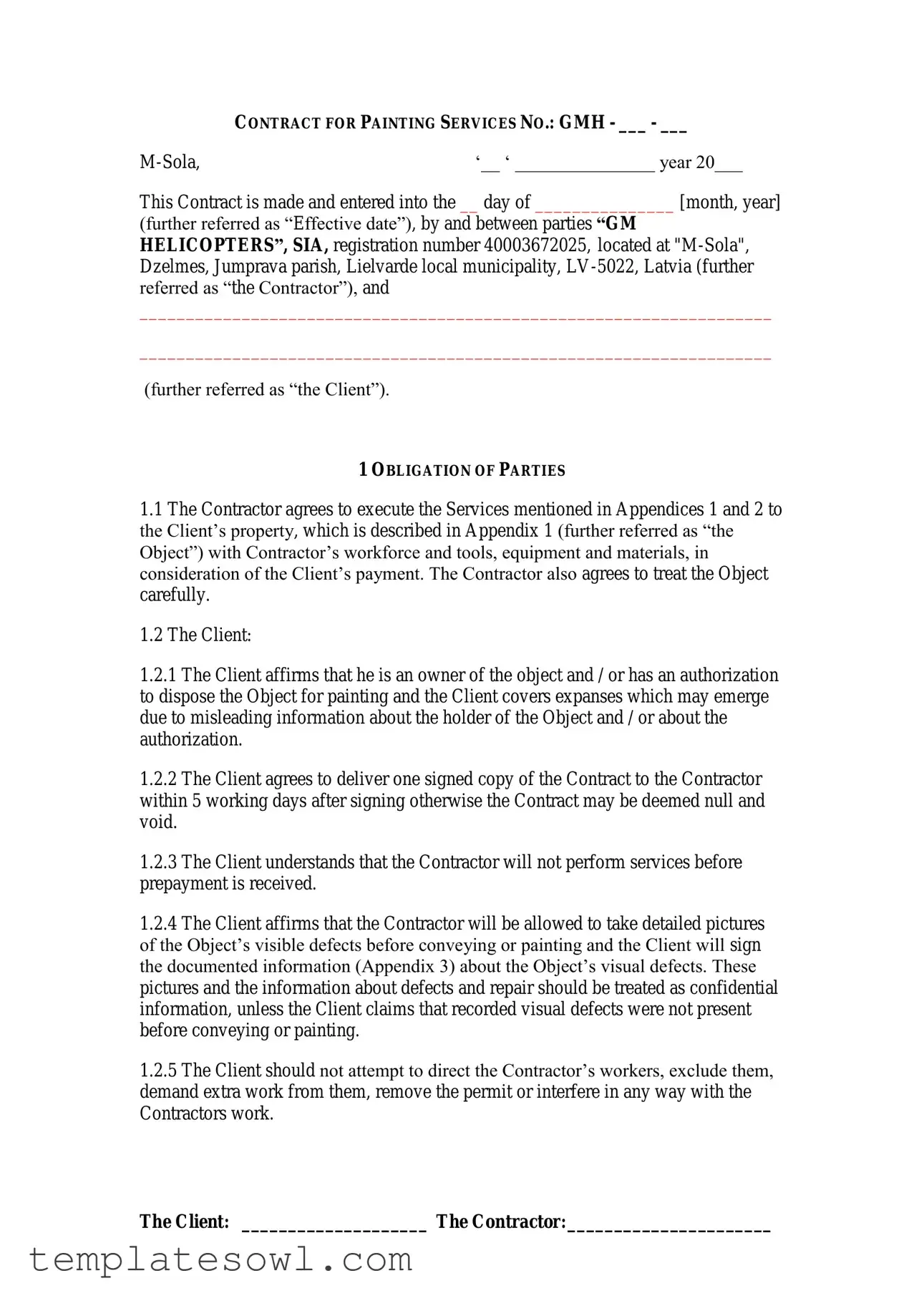|
CONTRACT FOR PAINTING SERVICES NO.: GMH - ___ - ___ |
M-Sola, |
„__ „ _______________ year 20___ |
This Contract is made and entered into the __ day of _______________ [month, year]
(further referred as “Effective date”), by and between parties “GM HELICOPTERS”, SIA, registration number 40003672025, located at "M-Sola", Dzelmes, Jumprava parish, Lielvarde local municipality, LV-5022, Latvia (further referred as “the Contractor”), and
____________________________________________________________________
____________________________________________________________________
(further referred as “the Client”).
1OBLIGATION OF PARTIES
1.1The Contractor agrees to execute the Services mentioned in Appendices 1 and 2 to the Client‟s property, which is described in Appendix 1 (further referred as “the Object”) with Contractor‟s workforce and tools, equipment and materials, in consideration of the Client‟s payment. The Contractor also agrees to treat the Object carefully.
1.2The Client:
1.2.1The Client affirms that he is an owner of the object and / or has an authorization to dispose the Object for painting and the Client covers expanses which may emerge due to misleading information about the holder of the Object and / or about the authorization.
1.2.2The Client agrees to deliver one signed copy of the Contract to the Contractor within 5 working days after signing otherwise the Contract may be deemed null and void.
1.2.3The Client understands that the Contractor will not perform services before prepayment is received.
1.2.4The Client affirms that the Contractor will be allowed to take detailed pictures of the Object‟s visible defects before conveying or painting and the Client will sign the documented information (Appendix 3) about the Object‟s visual defects. These pictures and the information about defects and repair should be treated as confidential information, unless the Client claims that recorded visual defects were not present before conveying or painting.
1.2.5The Client should not attempt to direct the Contractor‟s workers, exclude them, demand extra work from them, remove the permit or interfere in any way with the Contractors work.
The Client: ____________________ The Contractor:______________________
1.2.6The Client agrees to pay the prepayment, to accept the work done by the Contractor and to pay stipulated price in the volume and the time defined in this Contract.
2THE EXECUTION OF CONTRACTUAL OBLIGATIONS, TERMS AND CHANGES IN ORDERS
2.1All materials are specified and all work is performed in accordance with the specifications mentioned in Appendices 1, 2 and 4 in a professional and timely manner.
2.2Any changes in timing, orders or work amount which is requested or required due to the condition of the Object should be performed only after a written change order; it is signed by the Client upon the Contractors change order form (Appendix 5), and delivered to the Contractor accompanied by full payment for the change order if applicable.
3 STIPULATED PRICE AND PAYMENT PROCEDURE
3.1Stipulated Price includes expanses about necessary professional workforces, transportation, tools, equipment and materials and stipulated price may change, if any changes are made in timing, orders or work amount after a written change order, which is signed by both parties.
3.2In order to insure there are enough materials to do the work, the Contractor may order more materials than may be necessary to complete work. Excess materials will not result in a change of the stipulated price; however, materials remaining after completion of the work should belong to the Client.
3.3The stipulated price is written in the last invoice and it is agreed that it may be different from the estimated cost in connection with written change order, which is signed by both parties.
3.4The Client makes the upfront payment within 5 working days after calculations of the estimated cost (appendix 4) are received.
3.5The Contractor delivers final invoice to the Client after the certificate of acceptance is signed and it should be paid within 5 working days after the invoice is received.
4LIMITATION OF THE CONTRACTOR‟S LIABILITY
4.1The Contractor is not liable if the Object has any damage during transportation or painting, if the cause is not under the Contractor‟s supervision.
4.2The Contractor is not liable to cover the Object during convey, if the Client has not provided an appropriate cover.
The Client: ____________________ The Contractor:______________________
4.3The Contractor does not operate the Object, this is why the Contractor informs and the Client agrees that the Contractor should not be blamed about function decline or technical deterioration of the Object.
4.4The Contractor is not a dealer of painting materials and does not warrant materials used. The Contractor informs and the Client agrees that tonality and intensity of the color may vary from time to time.
5CONFIDENTIALITY
5.1.The parties agree that the confidential information can be described as and includes: technical and business information relating to proprietary ideas, patentable ideas copyrights or trade secrets, existing or contemplated products and services, software, schematics, research and development, production, costs, profit and margin information, finances and financial projections, customers, clients, marketing, and current or future business plans and models, regardless of whether such information is designated as “Confidential Information” at the time of its disclosure.
5.2.In addition to the above, Confidential Information should also include, and both parties have a duty to protect, other confidential or sensitive information which is: disclosed by any party in writing and marked as confidential (or with other similar designation) at the time of disclosure.
5.3.Both parties should limit disclosure of Confidential Information within its own organization to its directors, officers, partners, members or employees having a need to know and should not disclose Confidential Information to any third party without the prior written consent of the other party.
5.4.This Agreement imposes no obligation upon the Contractor with respect to any information: that was in the Contractor‟s possession before receipt from the Client, that is or becomes a matter of public knowledge through no fault of the Contractor, that is rightfully received by the Contractor from a third party not owing a duty of confidentiality to the Client, or that asks the Contractor to infringe the law.
6OTHER TERMS AND CONDITIONS
6.1.This Contract becomes effective when signed and provisions of the contract remains in full force and effect until commitments are met by both parties.
6.3.Any addition or modification to this Agreement must be made in writing and signed by authorized representatives of both parties.
6.4.This agreement is to be governed by the law of Latvia. Venue for any action other than a lien foreclosure may at the Contractor‟s option lie in its home county. The prevailing party should recover its attorney fees and costs.
The Client: ____________________ The Contractor:______________________
6.1.This Contract is made in two equal copies on four pages, which must be signed by both parties.
6.5Signed below certify that they have rights to act on behalf of parties – the Contractor and the Client. Both parties acknowledge that they have read and understood this contract and voluntarily accept the duties and obligations by their signatures below.
THE CLIENT |
THE CONTRACTOR |
Date: __________________________ |
Date: __________________________ |
Company:______________________ |
Company: |
_______________________________ |
GM HELICOPTERS, SIA |
|
Address: _______________________ |
Address: M-SOLA, Dzelmes, |
Jumprava Parish, Lielvarde Local |
_______________________________ |
Municipality, LV-5022, Latvia |
|
Name: _________________________ |
Name: Bebriss Aivars |
Signature:______________________ |
Signature: ______________________ |
Z.V.: |
Z.V.: |
Appendix 1 of the Contract No.: GMH - ___ - ___
Date: _____________________
ORDER
Please, write in block capitals and fill in the squares according to the sample:
, , , etc. means that signed below asks the Contractor to perform this service,
means that signed below asks the Contractor NOT to perform this service.
The Client asks to perform the Services on the Object (particular name): __________
_____________________________________________________________________
Transport
The Contractor is asked:
To convey the Object from: __________________________________________________
________________________________________________________________________
________________ to a suitable place to perform the painting (the Contractor‟s location)
To convey the Object from the Contractor‟s location to: ____________________________
________________________________________________________________________
_____________________________________________________________ after painting
The coordinator‟s name and telephone number (receipt and delivery): __________________
________________________________________________________________________
Materials and Equipment
The Contractor is asked:
To coordinate with the Client the materials and equipment needed:
Air Compressor and Paint Sprayer
Chemical and / or mechanical paint removers
Solvents for cleaning surfaces
Masking tape and paper
Primer
Paint type:
Enamel
Acrylic enamel
Polyurethane
Other (specify) ___________________________________
Paint thinner and catalyst or hardener
Preparation
The Contractor is asked:
To remove rust
To remove chrome or plastic trim, which can be removed easily
To remove the paint:
Chemically
Mechanically
To remove the paint:
To the bare metal
To the original primer
Sufficiently for the new paint to adhere to
To clean surfaces, using mineral spirits or denatured alcohol, to make sure no oils (including body oils from fingers and hands) are on the surfaces (recommended)
To use masking tape and paper to cover surfaces not to be painted, including glass, window trim, door handles, mirrors, and grills
Priming
The Contractor is asked:
To prime the surface with a corrosion resistant, self-etching primer, if all paint down to bare metal is removed
To grind all primed surfaces smooth after priming
To clean the surface after priming to remove any dust or oil that has accumulated during priming
Painting and Completion
The Contractor is asked:
To spray the finish paint on the Object
To spray the lacquer on the Object
To put removed chrome or plastic trim in appropriate place
Appendix 2 of the Contract No.: GMH - ___ - ___
Date: _____________________
SKETCH OF DESIRED PAINTING
WITH PAINT CODE IN RR OR RAL CATALOGUE
Signed below certifies that he has rights to act on behalf of the Client.
The Client:Z.V.:
_____________________________
(the signature and the transcript)
Appendix 3 of the Contract No.: GMH - ___ - ___
Date: _____________________
PICTURES / DRAWING OF THE OBJECT AT RECEPTION
AND DESCRIPTION OF VISIBLE DEFECTS AT RECEPTION
Signed below affirm that the Object had damages, which are portrayed in this document, before transportation and / or painting.
Signed below certify that they have rights to act on behalf of both parties.
The Client:The Contractor:
_____________________________ |
_____________________________ |
(signature and transcript) |
(signature and transcript) |
Z.V.: |
Z.V.: |
The visual defects were detected, the pictures were taken / the drawings were made and the table was filled by:
_____________________________
(signature and transcript)
Signed below certifies that he has rights to act on behalf of the Client.
Signed below affirms that the Object at reception had defects described above and any claims that recorded visual defects were not present before conveying or painting are false.
The Client:Z.V.:
_____________________________
(signature and transcript)
Appendix 4 of the Contract No.: GMH - ___ - ___
Date: _____________________
CALCULATIONS OF ESTIMATED COST
Service |
Timing |
Expenditures |
|
|
|
Without VAT
VAT (21%)
Total:
Prepayment ___%:




